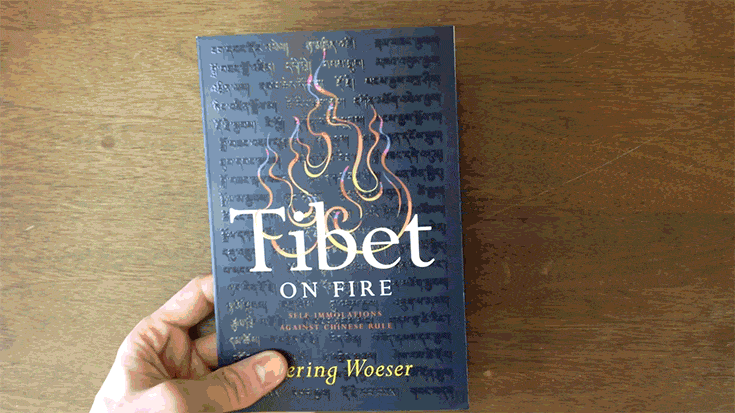
As the book moves, lights glints off the names of Tibetans who have self-immolated, printed on the cover in spot varnish.
The phenomenon of Tibetans—mostly monks and nuns, but also some citizens—immolating in protest of Chinese occupation has been going on since 2008. In that time, some 150 immolations have taken place. And while they may seem to have slowed down for the moment—there have been times when we’ve seen two or three incidents in a single week—they’re not over. In fact, just today it’s being reported that the first two immolation protests of 2016 have taken place, undertaken by a monk, who perished, and a 16-year-old citizen, who has survived.
We’ve long covered these controversial and tragic protests, including Robert Thurman’s excellent commentary, “A Cry for Freedom.” Now, a new book by pro-Tibet activist and International Women of Courage awardee Tsering Woeser keeps the discussion going. That book, Tibet on Fire, is her attempt “to analyze and understand these acts of self immolation. It is furthermore a critique: a critique of the Chinese communist authorities and their wanton exercise of power, as well as a critique of the global community, which has shown itself to be far to willing to compromise with this power.”
Given that the outcry against China’s treatment of Tibet often seems to go unnoticed, a book like this one can use all the help it can get. So it’s notable that Tibet on Fire‘s cover was designed by internationally acclaimed activist and artist Ai Weiwei, who is famously in opposition to Chinese rule. The cover features a thangka-style flame motif against a black cover that includes, in spot-varnish, a list of Tibet’s self-immolators.
About the cover’s conception, The Guardian reported in 2013:
Woeser said that she considers Ai a friend, and called his views on Tibetan issues, which she had seen on Twitter, “very pertinent, and very precise.” She asked him to design the cover in late August. “He agreed immediately,” she said. “He said of course, the meaning of these self-immolations, whether on a philosophical or a religious level, is beyond what us living people can ordinarily understand. But he said he’d be willing to try.”
The final result is a fine match for the book’s contents: mournful and strong, but darkly beautiful too. Let’s hope that people will notice it.
Tibet on Fire is available now. Read more about it here.
